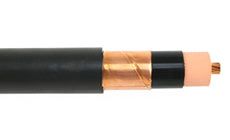Product Details
This cable is made of a concentrically stranded compressed Class B copper conductor, which is annealed making the conductor soft and malleable. The use soft annealed copper conductor improves the flexibility of the cable. Copper conductors are shielded with an extruded strand of a thermosetting semi-conductor layer that helps in controlling any form of stress acting on the conductors, as well as keeping the conductors at hold in their positions hence preventing them from collapsing.
The copper conductors after the shielding layer is applied they are insulated with an EPR, that is shielded with an extruded insulation shield of a polymeric thermosetting semi-conductor which is separated from the insulation. EPR refers to Ethylene Propylene Rubber and it improves the adaptive features of this cable, making it a good electrical conductor. The assembly is wrapped with a shielding metallic tape of annealed copper and jacketed with the Polyvinyl Chloride (PVC). It is then tested to check if it complies with all the necessary international specification standards such as:
1.Underwriters Laboratory (UL) 1072
2.UL 1685
3.Flame test IEEE 1202
4.NEC 250.4
Why go for this Cable?
A flexible cable is the type of cable to go for instead of the rigid and stiff counterparts. Imagine installing a cable in the corners of your power lines and you have the chance to choose between deploying rigid cables and flexible ones, which one would you go for? Of course you won’t hesitate on picking cables with good flexibility. This is because flexible cables are easy to bend since they do not require too much of labor effort thus relieving you from unnecessary cost; such cables are also cost effective. On the other hand, rigid and stiff cables are time consuming as they are difficult and tiresome to handle as compared to flexible cables. Soft copper conductors affirms the flexibility of this cable.
Shielding of cables may be seen as a simple feature, but as far as electrical safety and performance feature it is a thing to consider. Shielding is either made of braided copper or an aluminum foil. The copper conductor of this cable is shielded with an extruded layer of a thermosetting semi-conductor made of copper. It helps in controlling any kind of stress attacking the cable. Stress could occur when cables falls on the ground or when they get hit from outside. This shielding is also responsible for holding the conductors firmly in their positions, preventing any further contacts that may occur.
Insulation
Insulation is a very important aspect when it comes to electrical transmission. You need insulated cables because they offer protection to your life and the cable. Handling bare live conductors carrying electric current is dangerous and should be avoided at all cost. Well, it sounds simple but the truth is you will get electrocuted whenever you get into contact with bare power conductors. Ethylene Propylene Rubber (EPR) of this cables covers your life away from electric shocks. This cable is designed for outdoor applications where it is subjected to operate under harsh environmental conditions such as strong sunlight radiation, moisture, abrasion and corrosive chemicals. EPR protects the cable from such conditions.
Polyvinyl Chloride (PVC) jacketing is a tough outer layer that offers a great protection to the cable. PVC is known to be fungal resistant, meaning that it is not biodegradable even when buried directly. It is flame retardant, moisture resistant, and repellant to corrosive chemicals, oils and gas. This cable is jacketed with PVC making it a preferred cable of choice especially for use in harsh environmental conditions.
Applications
It is meant for use as a main feeder as well as branch circuiting for industrial, commercial and electric utility applications. This cable can be installed through direct burial, underground duct and conduit open tray systems. You can deploy it in either wet or dry areas as it has a cold bend operating temperature of -40 degrees Celsius up to 250 degrees Celsius for short circuiting in dry conditions.
| Technical Specifications: | |
| Number of Conductors in Cable: | 1 |
| Jacket Thickness (mils): | 55 |
| Nominal Insulation Thickness (mm): | 115 |
| Size AWG: | 1 |
| Stranding: | 19 |
| Diameter Over Insulation (Inches): | 0.590 |
| Diameter Over Insulation Shield (Inches): | 0.680 |
| Diameter Complete Cable (O.D.) (Inches): | 0.880 |
| Weight Per 1000ft Total (Lbs.): | 620 |
| Ampacity 1/C in Cable Tray (Amps): | n/a |
| Ampacity 1/C Conduit in Air (Amps): | 190 |
| Allowable Ampacity in Ducts (Amps): | 185 |

